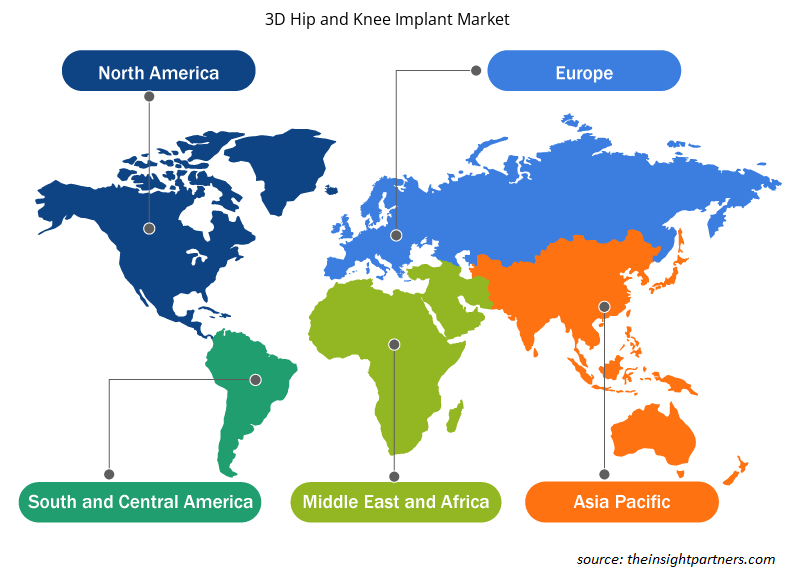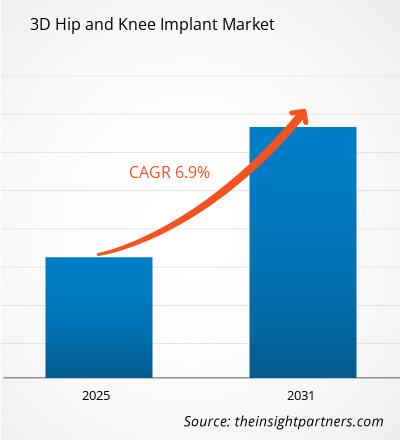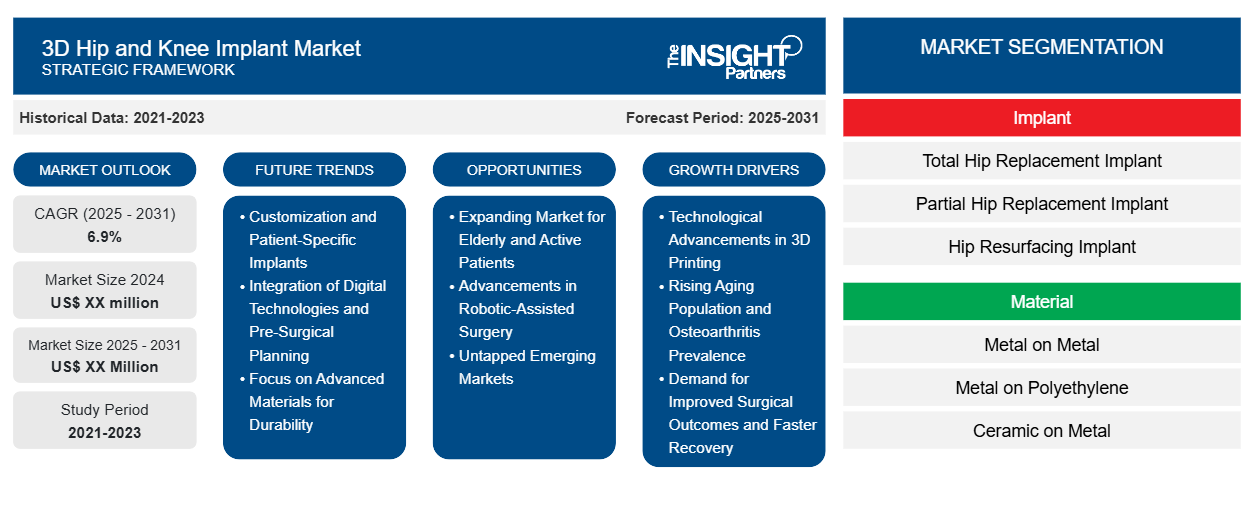3D 髋关节和膝关节植入物市场预计在 2023 年至 2031 年期间的复合年增长率为 6.9%,市场规模将从 2023 年的 XX 百万美元扩大到 2031 年的 XX 百万美元。
报告按植入物(全髋关节置换植入物、部分髋关节置换植入物、髋关节表面置换植入物和髋关节置换翻修植入物);材料(金属对金属、金属对聚乙烯、陶瓷对金属、陶瓷对聚乙烯和陶瓷对陶瓷);最终用途(医院、骨科诊所和其他)进行细分。全球分析进一步细分为区域和主要国家。报告以美元为单位提供上述分析和细分的价值。
报告目的
The Insight Partners 发布的《3D 髋关节和膝关节植入物市场》报告旨在描述当前形势和未来增长、主要驱动因素、挑战和机遇。这将为各种业务利益相关者提供见解,例如:
- 技术提供商/制造商:了解不断变化的市场动态并了解潜在的增长机会,从而能够做出明智的战略决策。
- 投资者:对市场增长率、市场财务预测以及整个价值链中存在的机会进行全面的趋势分析。
- 监管机构:监管市场政策和警察活动,旨在最大限度地减少滥用行为,维护投资者的信任和信心,维护市场的完整性和稳定性。
3D 髋关节和膝关节植入物市场细分
注入
- 全髋关节置换植入物
- 部分髋关节置换植入物
- 髋关节置换植入物
- 髋关节置换术
材料
- 金属与金属
- 聚乙烯上的金属
- 金属上的陶瓷
- 聚乙烯上的陶瓷
- 陶瓷与陶瓷
最终用途
- 医院
- 骨科诊所
- 其他的
地理
- 北美
- 欧洲
- 亚太
- 南美洲和中美洲
- 中东和非洲
地理
- 北美
- 欧洲
- 亚太
- 南美洲和中美洲
- 中东和非洲
定制此报告以满足您的需求
您可以免费定制任何报告,包括本报告的部分内容、国家级分析、Excel 数据包,以及为初创企业和大学提供优惠和折扣
- 获取此报告的关键市场趋势。这个免费样品将包括数据分析,从市场趋势到估计和预测。
3D 髋关节和膝关节植入物市场的增长动力
- 3D 打印技术进步:3D 髋关节和膝关节植入物市场增长的决定因素之一是 3D 打印技术的发展。3D 打印使设计完全适合患者结构的植入物成为可能,从而增强贴合度、舒适度和功能。这些单独的植入物有助于更好地进行手术和快速愈合,从而拉动骨科市场的需求曲线。
- 老龄人口增加和骨关节炎患病率上升:全球老年人口的增加极大地推动了 3D 髋关节和膝关节植入物市场的发展。由于年龄的增长,骨关节炎和关节退化等疾病往往会发生,导致关节置换手术的数量增加。3D 植入物可再生,接受钢板手术。出于这些原因,在这些干预措施中,3D 植入物是首选。
- 对改善手术结果和加快恢复的需求:对术后患者结果改善的关注使得 3D 打印髋关节和膝关节植入物在当今市场非常受欢迎,其相应的手术也大受欢迎。与普通植入物相比,此类植入物在贴合度和生物力学性能方面表现出更高的公差。为了提高手术质量、减少并发症、缩短住院时间并取得积极的手术效果,医疗保健提供者正在接受 3D 植入物,因为它们具有优越的性能和患者定制功能。
3D 髋关节和膝关节植入物市场未来趋势
- 定制和患者专用植入物:此外,3D 髋关节和膝关节植入物市场中迅速流行的另一个主要趋势是,人们越来越愿意使用所谓的患者匹配植入物。事实上,借助 3D 打印技术,甚至可以制造出完全符合身体精确轮廓的植入物,从而提供更高的舒适度和可用性以及更长的植入物寿命。由于这些影响,这一趋势令人鼓舞,因为它改善了手术效果,并最大限度地降低了任何并发症的风险。
- 数字技术与术前规划的整合:CAD 与虚拟手术规划等技术的结合以及 3D 打印技术在手术中的应用也成为另一个趋势。医生利用患者 CT 图像制作的 3D 图像来更精确地设计手术。这种方法最大限度地减少了植入物的潜在错位(这是手术效果不佳的原因之一),从而为患者带来更好的手术效果。
- 专注于耐用的先进材料:3D 髋关节和膝关节植入物市场趋势是采用新时代的坚固材料。该公司正在使用生物相容性钛和先进的聚合物复合材料制造 3D 植入物。它们还提供了增强的耐磨性和更长的植入物耐用性,解决了植入物失效和需要干预来更换的问题,从而促进了市场的增长。
3D 髋关节和膝关节植入物市场机会
- 扩大老年和活跃患者的市场:随着全球老年人口的增加,这为 3D 膝关节和髋关节植入物市场的增长提供了良好的机会。不仅老年患者,而且患有关节并发症的年轻和活跃患者也对适合且功能良好的植入物非常感兴趣。市场的增长可能带来两个年龄组的采用率增长。
- 机器人辅助手术的进步:使用机器人技术的微创手术的发展为 3D 髋关节和膝关节植入物市场的增长开辟了一条道路。机器人机器可以帮助更好地放置植入物,从而可以更好地放置 3D 打印植入物。机器人手术和植入物 3D 打印的结合提高了患者的治疗效果,缩短了康复时间,并为以前不存在的复杂骨科手术创造了一个新市场。
- 尚未开发的新兴市场:亚太、拉丁美洲和非洲等发展中地区的医疗保健系统和可支配收入不断提高,为 3D 髋关节和膝关节植入物市场带来了巨大潜力。该地区的骨科手术数量急剧增加,因此对独特且 3D 设计的植入物的需求必然会激增,从而推动这些未开发地区的发展。
3D 髋关节和膝关节植入物市场区域洞察
Insight Partners 的分析师已详尽解释了预测期内影响 3D 髋关节和膝关节植入物市场的区域趋势和因素。本节还讨论了北美、欧洲、亚太地区、中东和非洲以及南美和中美洲的 3D 髋关节和膝关节植入物市场细分和地理位置。

- 获取 3D 髋关节和膝关节植入物市场的区域特定数据
3D 髋关节和膝关节植入物市场报告范围
| 报告属性 | 细节 |
|---|---|
| 2023 年的市场规模 | XX 百万美元 |
| 2031 年市场规模 | XX 百万美元 |
| 全球复合年增长率(2023 - 2031) | 6.9% |
| 史料 | 2021-2022 |
| 预测期 | 2024-2031 |
| 涵盖的领域 | 通过植入
|
| 覆盖地区和国家 | 北美
|
| 市场领导者和主要公司简介 |
|
3D 髋关节和膝关节植入物市场参与者密度:了解其对业务动态的影响
3D 髋关节和膝关节植入物市场正在快速增长,这得益于终端用户需求的不断增长,而这些需求又源于消费者偏好的不断变化、技术进步以及对产品优势的认识不断提高等因素。随着需求的增加,企业正在扩大其产品范围,进行创新以满足消费者的需求,并利用新兴趋势,从而进一步推动市场增长。
市场参与者密度是指在特定市场或行业内运营的企业或公司的分布情况。它表明在给定市场空间中,相对于其规模或总市场价值,有多少竞争对手(市场参与者)存在。
在 3D 髋关节和膝关节植入物市场运营的主要公司有:
- 齐默邦美
- 史赛克
- 史密斯和侄子
- 阿斯库拉普
- 精密技术
免责声明:上面列出的公司没有按照任何特定顺序排列。

- 获取 3D 髋关节和膝关节植入物市场顶级关键参与者概览
主要卖点
- 全面覆盖:该报告全面涵盖了 3D 髋关节和膝关节植入物市场的产品、服务、类型和最终用户的分析,提供了整体概况。
- 专家分析:报告基于对行业专家和分析师的深入了解而编写。
- 最新信息:该报告涵盖了最新信息和数据趋势,确保了其与业务的相关性。
- 定制选项:此报告可以定制以满足特定客户要求并恰当地适应业务策略。
因此,3D 髋关节和膝关节植入物市场研究报告有助于引领解读和了解行业情景和增长前景。尽管可能存在一些合理的担忧,但本报告的总体优势往往大于劣势。
- 历史分析(2 年)、基准年、预测(7 年)及复合年增长率
- PEST和SWOT分析
- 市场规模、价值/数量 - 全球、区域、国家
- 行业和竞争格局
- Excel 数据集
近期报告
客户评价
购买理由
- 明智的决策
- 了解市场动态
- 竞争分析
- 客户洞察
- 市场预测
- 风险规避
- 战略规划
- 投资论证
- 识别新兴市场
- 优化营销策略
- 提升运营效率
- 顺应监管趋势





















 获取免费样品 - 3D髋关节和膝关节植入物市场
获取免费样品 - 3D髋关节和膝关节植入物市场